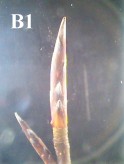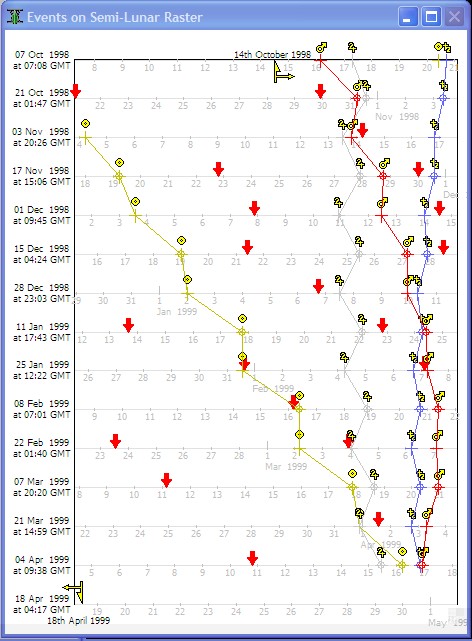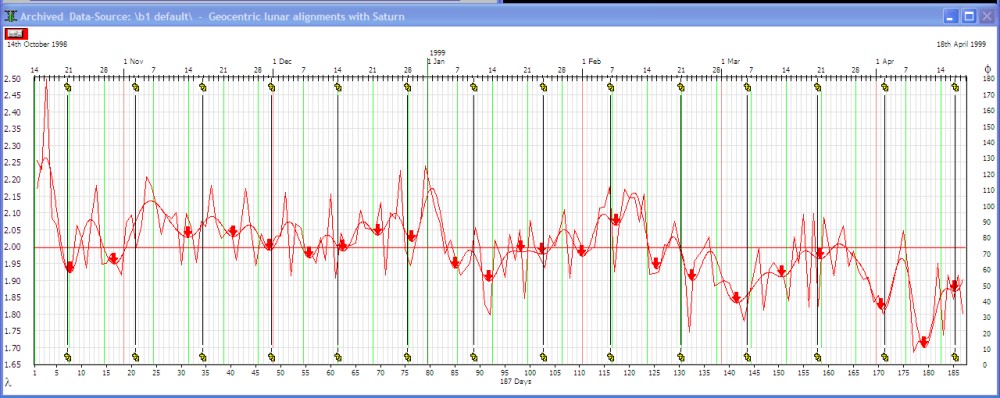Home Page
Site Map
← Previous - the OBOB hypothesis
Next - Beech b1 Tuned →
Beech Bud b1, 1998/1999, Original Results
 |
When Beech-bud number one of the two, called, simply, b1, first had its λ measured and charted day-by-day over its season, it did not seem especially to acknowledge any planet.
The dips were temporally scattered; even if the distribution could not be deemed entirely random (and just how is one expected to ‘deem’ anything of the kind?), it certainly seemed not to show rhythm.
This was atypical–and discouraging. In fact, I supposed the bud defective, and set it aside. |
That you may judge these things for yourselves, here is the chart, lifted straight from the Bud Workshop screen—
Fourier Analysis and Synthesis, with the latter done on Fourier components, from order zero to order twenty seven, has been used to “smooth” the raw data somewhat, the better to tease the dips out from the general noise, and from whatever else might be going on with the bud. The result is the gentle curve superimposed on the noisy, jagged one.
The times of geocentric alignment (i.e., of conjunction and opposition, alternately) of the Moon with Saturn are shown (by the vertical lines between the little, yellow ‘Saturn’ icons), but it will probably be agreed that there is no very obvious correlation of these alignments with the dips indicated by the red down-arrows–and so it was with the other bodies, too.
 |
The lack of correlation is perhaps better seen on the corresponding “Semi-Lunar Raster” diagram, shown left.
The horizontal “raster” lines, coming one after the other down the chart, mark the periods of successive sweeps of the Moon over exactly half its orbit. If one line represents the period of a sweep from perigee to apogee, the next line represents the exactly similar period of the return sweep from apogee to perigee.
The timings of the “axial moments” of the Moon (that is, when it lies in the major axis of its orbit and so either in perigee or apogee–which is to say, in one of the apsides of the lunar orbit) are given down the left side of the graph.
This is a Moon-driven clock, accurate to at least 13 decimal places.
The timings of the lunar alignments of Mars, Jupiter and Saturn, and of the Sun, are marked on the raster lines, and the moments of the minima, or ‘dips’, of the bud's λ value are indicated on the raster lines by the same kind of red down-arrow that marks them on the chart above.
Now, if there is temporal correlation of a bud with a body, a majority of the dip-arrows line up alongside, or on, the alignment-track of that body, and more or less accurately pace it down the chart.
No such line-up leaps to the eye here.
But this was before tuning. |
Tuning, when it came, was done by a digitally-simulated Resonant Filter,
identical in principle to those used in radio receivers to select stations.
For Beech bud b1, the filter was, in the jargon of the radio engineer, “made hi-Q” (= 500) , to give it a very narrow bandwidth and render it strongly selective.
It was tuned precisely to the Fourier order corresponding to Saturn's Lunar Alignment Dominant, obtained from Saturn's Lunar Alignment Spectrum pertaining to the time-span, or “Grand Period”, of the b1 observations.
Less technically put, the filter was "sharply tuned" to Saturn's frequency, and its ‘hi-Q’ selectivity meant that it powerfully rejected λ-variation with frequencies that were not very close indeed to Saturn's frequency. A hi-Q filter behaves with respect to λ-variation somewhat as a high-wire, or tightrope, behaves with respect to its would-be users—safe passage is afforded to those who can keep their feet on it! Those who can't disappear into the abyss. Passage through a medium-Q filter might be equivalent to walking the plank, and through a lo-Q one equivalent to negotiating, say...oh, Scotland's Forth Road Bridge, or San Francisco's Golden Gate Bridge.
It will be appreciated that using a hi-Q filter meant that the amplitude and phase (timing) of the throughput could vary, but the frequency of it could diverge only very slightly from the optimum. In high-wire terms, there could be users of any stature (amplitude) crossing at any time (phase), but only those able to step precisely on the wire (frequency) would cross successfully.
In respect of the OBOB hypothesis, this trade-off of constraints proved most interesting.
Home Page
Site Map ← Previous - the OBOB hypothesis
Next - Beech b1 Tuned →


